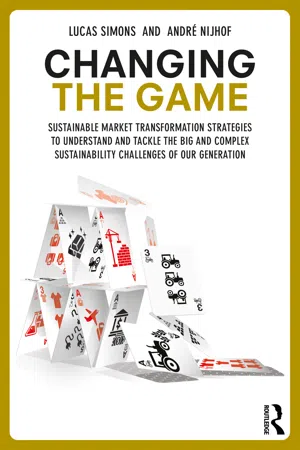
Changing the Game
Sustainable Market Transformation Strategies to Understand and Tackle the Big and Complex Sustainability Challenges of Our Generation
- 320 pages
- English
- ePUB (mobile friendly)
- Available on iOS & Android
Changing the Game
Sustainable Market Transformation Strategies to Understand and Tackle the Big and Complex Sustainability Challenges of Our Generation
About this book
We are at the beginning of the sustainability era. The biggest challenge of our generation is to reach the Sustainable Development Goals. For this we must be willing to understand and change the root causes that create these challenges in the first place. The system itself needs to change. But how to do that?
This ground-breaking book Changing the Game reveals the missing insights and strategies to actually achieve system change. The authors Lucas Simons and André Nijhof bring decades of real life and academic experience, and state that most of the sustainability challenges are actually caused by the same system failures, every time. Therefore, the way to accelerate and manage system change is also similar every time – if you know where to look and how to act.
The theory of sustainable market transformation and system change is described in a compelling and easy to understand eight-step approach applied to eight different sectors. The authors, together with respected sector experts, describe the drivers, triggers and dominant thinking in each of these sectors as well as the strategies needed to move towards higher levels of sustainability.
This book is highly accessible and engaging, and is perfect for use by professionals, leaders and students for understanding how to move markets to a more sustainable future.
Frequently asked questions
- Essential is ideal for learners and professionals who enjoy exploring a wide range of subjects. Access the Essential Library with 800,000+ trusted titles and best-sellers across business, personal growth, and the humanities. Includes unlimited reading time and Standard Read Aloud voice.
- Complete: Perfect for advanced learners and researchers needing full, unrestricted access. Unlock 1.4M+ books across hundreds of subjects, including academic and specialized titles. The Complete Plan also includes advanced features like Premium Read Aloud and Research Assistant.
Please note we cannot support devices running on iOS 13 and Android 7 or earlier. Learn more about using the app.
Information
1

What are the sustainability challenges of our generation?
1 The biggest challenges of our generation
1.1 Overshoot Day

1.2 Staying within planetary boundaries
- 1. Freshwater consumption;
- 2. Climate change;
- 3. Land use/conversion and degradation;
- 4. Biodiversity loss;
- 5. Ocean acidification;
- 6. Depletion of the ozone layer;
- 7. Chemical pollution;
- 8. The release of aerosols into the atmosphere (air pollution);
- 9. Disruption to the biogeochemical cycle (e.g. through excessive use of nitrogen-based fertilizers).
- Changes to the global nitrogen cycle;
- Climate change;
- Land-use conversion;
- Biodiversity loss.
Overshoot one: nitrogen, the unknown killer
- Excess nitrogen in the form of fertilizers is leached away – almost 50% of it is not absorbed by plants – and enters our water systems, resulting in serious eutrophication of freshwater systems and acidification of terrestrial ecosystems. This leads to rapid algae growth, which impacts the ecosystems of water bodies by blocking sunlight, using up oxygen for other species and releasing toxins that are harmful to animals.12 As a result, excessive nutrients like nitrogen in the water can cause a “dead zone”: oxygen-deficient areas in which nothing can live. In March 2004, the UN Environment Program published its first Global Environment Outlook Yearbook in which it reported 146 dead zones in the world's oceans where marine life could not be supported due to depleted oxygen levels. Some of these zones were as small as a square kilometer (0.4 mi²), but the largest dead zone covered 70,000 square kilometers (27,000 mi²). A study in 2008, four years later, reported a total of 405 dead zones worldwide;13,14
- Nutrient pollution in the air also causes acid rain which in turn affects lakes, forests and animals.15 Acid rain has very damaging effects on life on land and below water. A healthy lake, for example, has a pH of 6.5 or higher. Acid rain causes the pH to fall below 5, which is detrimental to fish life. At a pH below 4, the lake is biologically dead.16 Some lakes in Sweden have become so acidic that they are no longer able to support fish life.1...
Table of contents
- Cover
- Endorsements
- Half-Title
- Title
- Copyright
- Contents
- List of contributors
- Introduction by Lucas Simons and Andre Nijfhof
- Preface by Paul Polman
- Acknowledgements
- 1 What are the sustainability challenges of our generation?
- 2 What is causing these sustainability problems?
- 3 How do we solve this?
- 4 The models applied: eight sectors in transition
- 5 How can you apply sustainable market transformation theory to your own practice?
- Notes
- Index